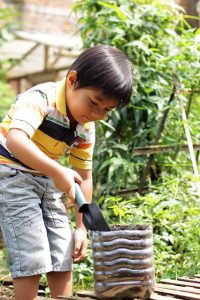Young Children
 This is the quintessential time of childhood, with fairy tales and imagination, tumbling and playing, first friends, real conversations, and your child revealing more and more of who he or she is and what gifts and interests he or she brings. It is also a period of inconsistency, with your child showing surprising competence some of the time and immaturity other times. Thinking between the ages of 2 and 5 has a very uneven and variable quality. (You will see unevenness again during the teen years.) Age 6-7 is often seen as transitional, as your child begins to enter middle childhood and a more consistent way of being.
This is the quintessential time of childhood, with fairy tales and imagination, tumbling and playing, first friends, real conversations, and your child revealing more and more of who he or she is and what gifts and interests he or she brings. It is also a period of inconsistency, with your child showing surprising competence some of the time and immaturity other times. Thinking between the ages of 2 and 5 has a very uneven and variable quality. (You will see unevenness again during the teen years.) Age 6-7 is often seen as transitional, as your child begins to enter middle childhood and a more consistent way of being.
Building healthy eating habits
By the time children are about a year old, they begin to need a more varied diet containing whole foods. Calorie needs increase from about 1000 calories a day at age one, to about 1400 by age 5. According to the American Academy of Pediatrics (AAP), as a rough guideline, toddlers between the ages of one and three need about 40 calories for every inch of height.
Nutritional Needs of Young Children. Children over the age of two . . .
Just about every child will learn to read, do math, reason, use a computer and do all kinds of other intelligent things. But a lot of parents worry about how to boost brain power and stimulate social and intellectual development. It turns out there actually is something that helps. Across the board. I’m going to share the “secret.” Then I’m going to tell you what we know about it and why it really does make a difference.
TALK WITH YOUR CHILD
A new set of feelings emerges during early childhood called secondary or complex emotions
They differ form the primary emotions (distress, disgust, interest, happiness or contentment, sadness, fear, anger and surprise) in several ways. Most importantly, they aren’t just biologically given, rather they are learned and require both cognitive and social information. Sometimes these are called “self-conscious emotions” because most involve some evaluation of the self against a set standards, resulting in enhancing or diminishing one’s sense of self.
Secondary emotions include: pride, shame, guilt . . .
Forming one’s self identity begins in early childhood, shortly after children begin to recognize themselves in a mirror, a milestone that often emerges around 18 months or so.
The classic test of self recognition is the “rouge” test. If you’d like to try it, discretely place a dot of cream blush or lipstick (or watercolor paint if you prefer) on your finger, without your child seeing, and casually touch it to your child’s forehead. Wait a couple of minutes then get your child . . .
Social play with peers is particularly important because, unlike play with a parent, in which there is an implicit power structure, peer interactions have a more even distribution of power. Peer play places children in control, providing opportunities for self-directed learning and learning through shared experiences.
In particular, social play lets children explore ways to use symbols, gestures, and language, challenging and exercising their developing linguistic abilities. In pretend play, children often enact narratives, in which they collaborate to develop or recreate a story . . .
Developmental scientists classify play into a number of different types, notably object play, physical play, and pretend play. Each of these can become forms of social play when they are shared with another person.
Each of these three general forms of play emerge in infancy, during the 12 - 24 month period.
The very first object play appears around a year. If you see your year-old child do something like pick up a phone, hold it to her ear and jabber, you are seeing the very beginnings of object play. Your child at this point is doing culturally appropriate things . . .
It is easy to underestimate the value of play. As adults, our “play” takes place during leisure time and we see it as fun and lighthearted. We regard it as recreational, with no practical purpose, other than unwinding, having fun, or spending time with friends. It nurtures us, but we don’t regard it as serious. Since it has this lightness for us, we often find it hard to appreciate that play has an enormously important role in the lives of children.
Play is the natural . . .
